MARIANI’S
Virtual Gourmet
September
20, 2015
NEWSLETTER
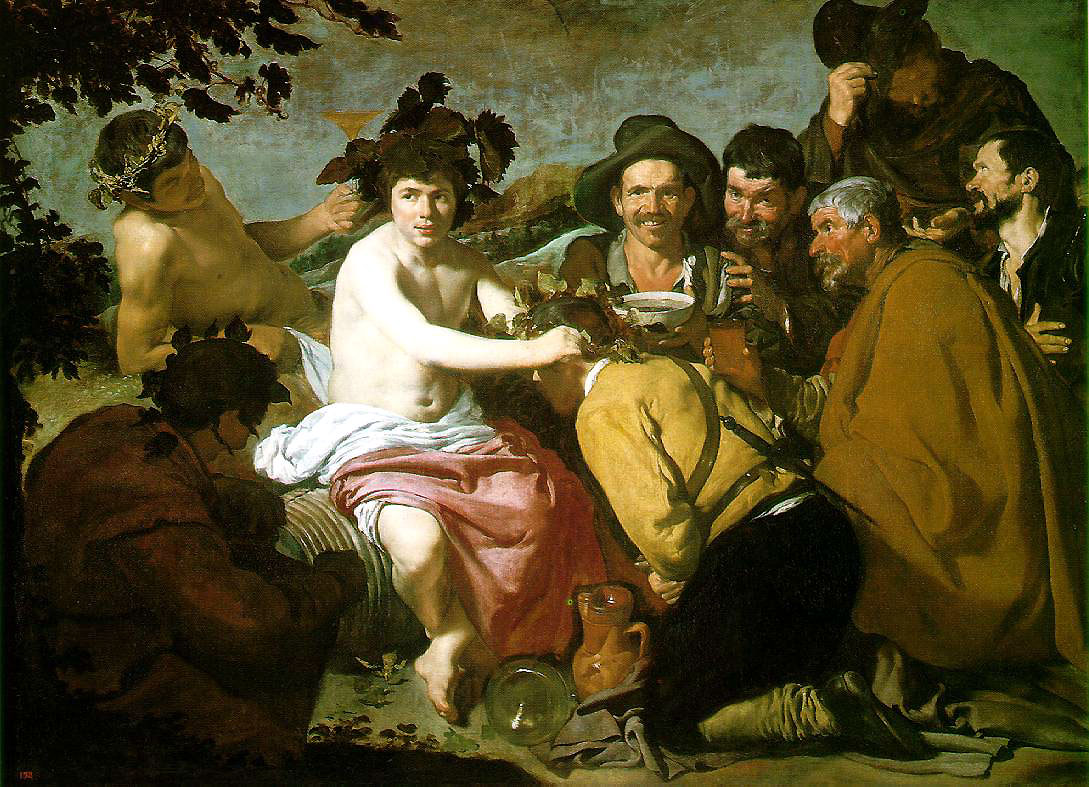
Diego
Velázquez, "Los Borrachos" (1628-1629)
IN THIS ISSUE
DINING IN NORTHERN CALIFORNIA'S
WINE COUNTRY
By Geoffrey Kalish
NEW YORK CORNER
LA SIRÈNE
By John Mariani
NOTES FROM THE WINE CELLAR
TWO BROTHERS INTENT ON MAKING PROSECCO
GO HEAD TO HEAD WITH CHAMPAGNE
By John Mariani
❖❖❖
DINING IN NORTHERN
CALIFORNIA'S WINE COUNTRY
By Geoffrey Kalish
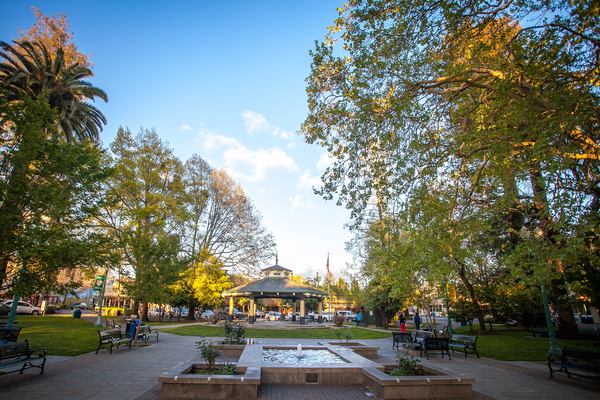 HEALDSBURG
HEALDSBURGOn the one hand, Healdsburg, in Sonoma County, typifies small-town America, with free Tuesday night live music in the Village Square and lots of pubs and eateries popular with locals. On the other hand, it represents the quintessential wine country tourist town, loaded with winery tasting rooms, gift shops and upscale, trendy restaurants. Amidst this split personality, two restaurants seem to span the gap, luring locals and tourists alike with their California fare.
Dry Creek
Kitchen
Healdsburg Hotel
317 Healdsburg Avenue
707-431-0330
www.drycreekkitchen.com
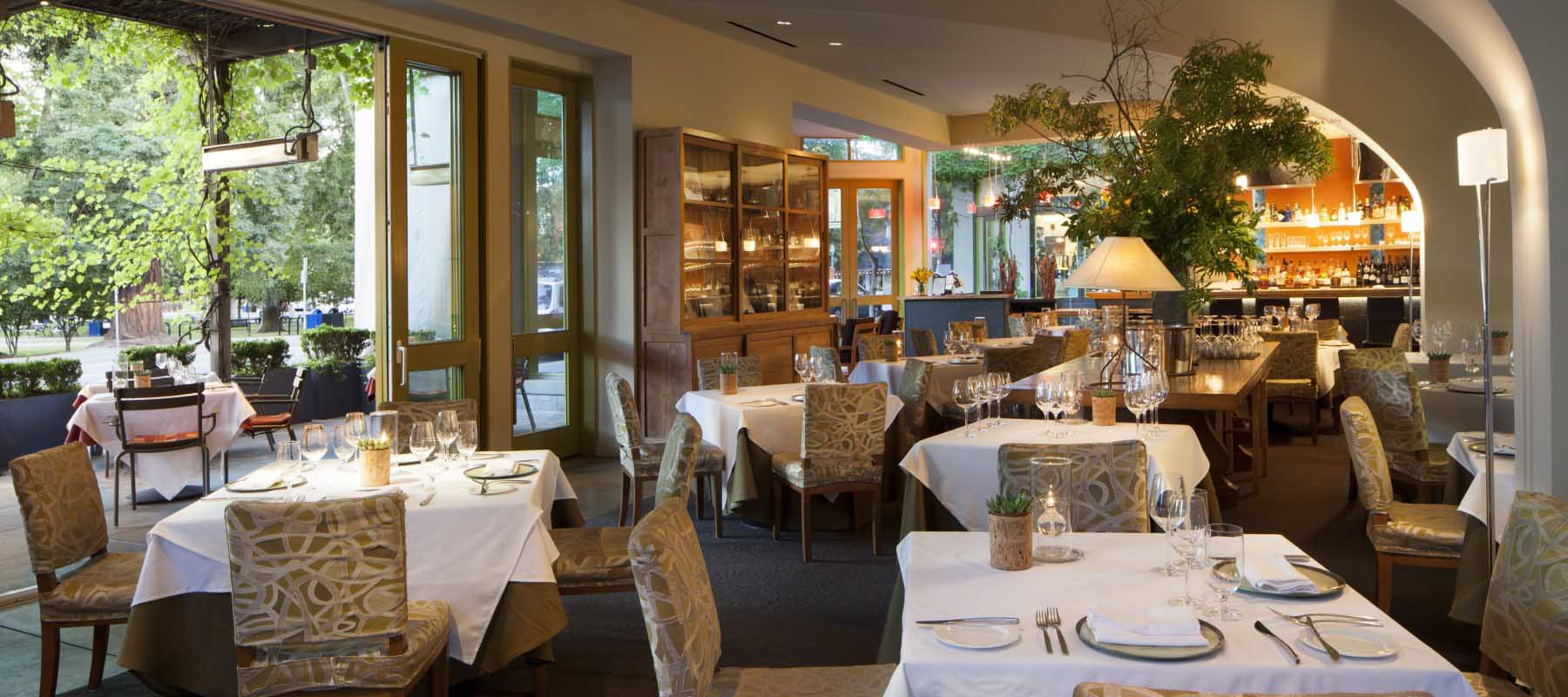
Owned
by chef/entrepreneur Charlie Palmer, this spacious
restaurant features indoor and outdoor dining areas
with blond wood tables dressed in starched white
cloths, comfortable padded chairs, and an airy view
of a small park. And, though Executive Chef Andrew
Wilson (by way of Chicago’s Tru and San Francisco’s
Kati Café) took over the reins of the kitchen only
seven months ago, he’s already making a name for
himself.
We chose the
five-course seasonal tasting menu (and accompanying
wine pairings), which brought tasty, artfully
decorated food, starting with a salad of grilled
Treviso lettuce and toasted pepitas
(pumpkin seeds) dressed with a luxuriant olive
vinaigrette paired perfectly by a dry, fruity 2012
Gundlach-Bundschu Gewürztraminer. 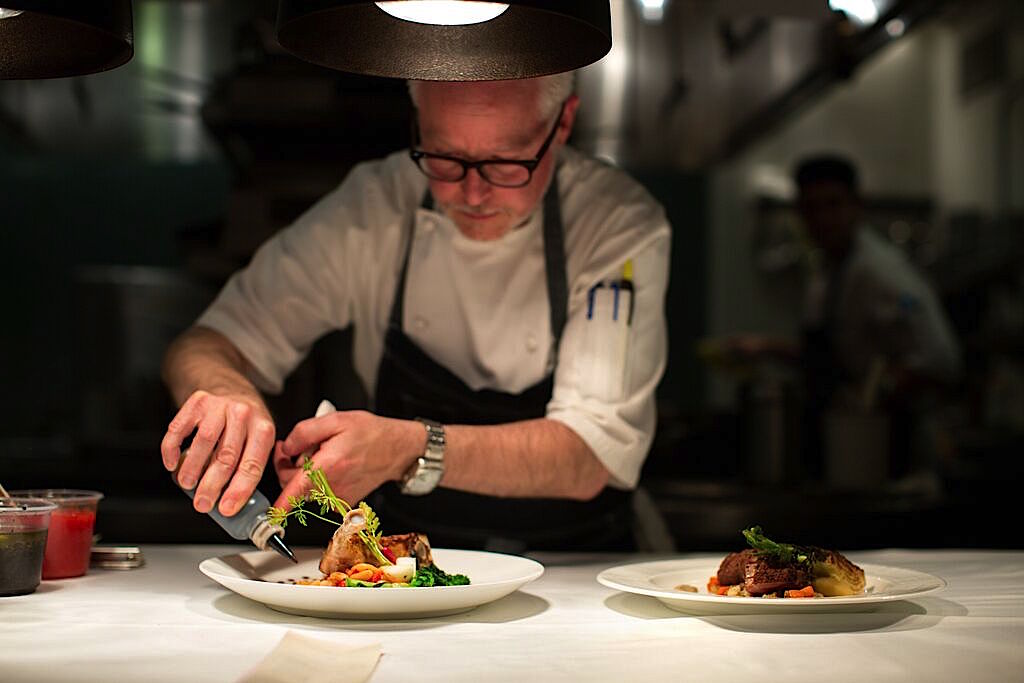
The next course of smooth
textured Comanche Creek pea risotto, Meyer
lemon, mint and Parmigiano-Reggiano, accompanied by
Belden Barns Grüner Veltliner from Sonoma Mountain,
epitomized the scent and fresh flavors of summer and
would convert any pea naysayers into legume lovers.
Even richer was the next course of potato-crusted
king salmon, with a crispy outside and mousse-like
inside, accompanied by a ratatouille of summer
squash, heirloom tomatoes and roasted eggplant
doused with a fragrant saffron vinaigrette, matched
with a 2012 Lioco Laguna Pinot Noir from Sonoma
Coast.
The main course was a memorable,
medium rare, char-grilled center cut steak with a
mustard seed Béarnaise, housemade pastrami, rye
gnocchi, and red onion relish (right),
accompanied by a fruity, intense North Coast 2012
Papa’s All-Blacks “Old Vine” blend 201.
For dessert we enjoyed a
selection of local cheeses, each served with a
different fruit jam, compote or chutney and
accompanied by an unctuous 2012 Arrowood Late
Harvest Riesling.
Dinner
served nightly. The tasting dinner costs $79 per
person ($9 additional for the cheese course), with
accompanying wine pairing a very reasonable $48
per person.
Valette
344 Center Street
707-473-0946
www.valettehealdsburg.com
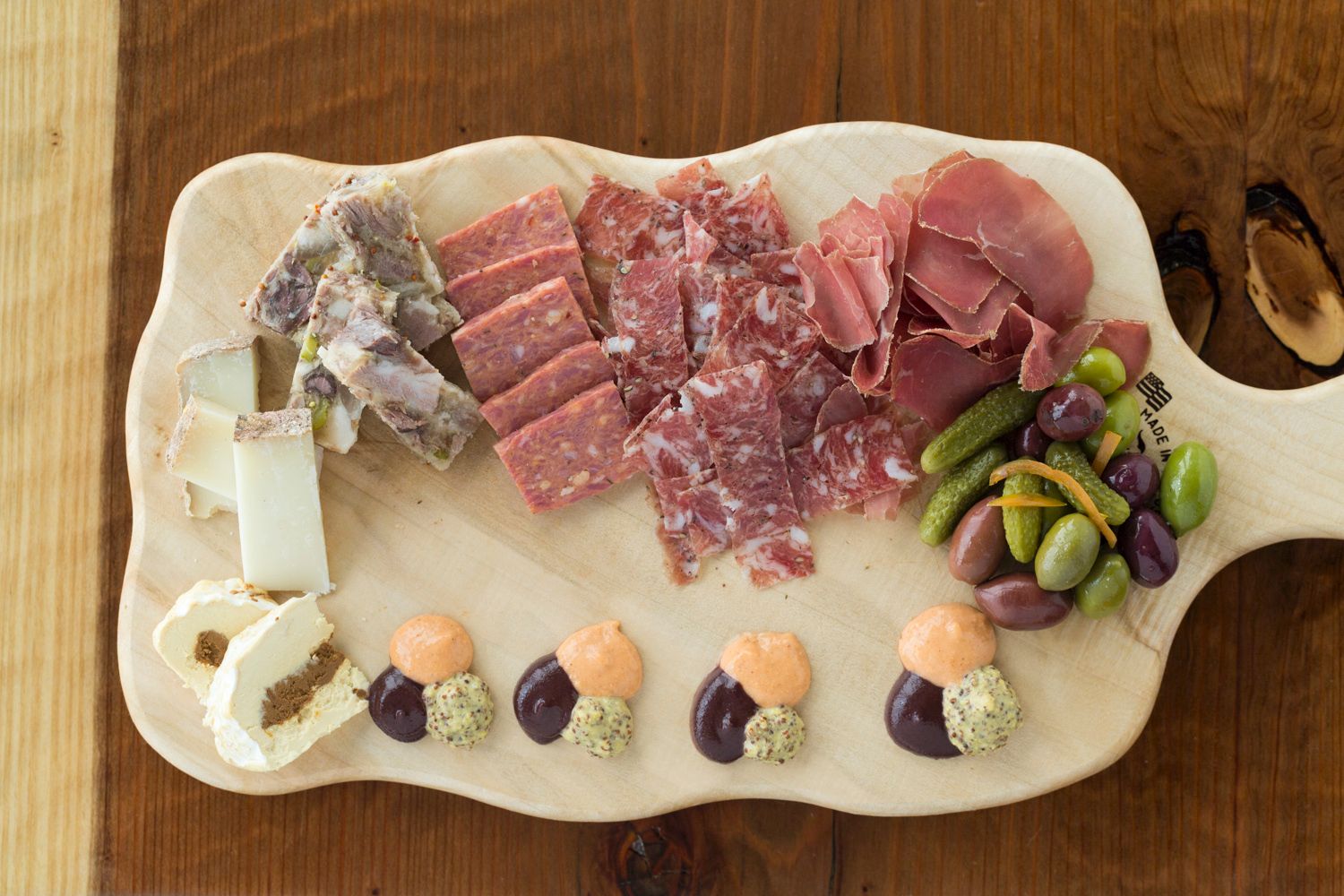 Barely
six months ago, Dustin Valette (previously chef at
nearby Dry Creek Kitchen above) and his brother
Aaron converted the former long-running Restaurant
Zin into a showcase for toothsome, innovative
cuisine, featuring fare from local farms. Amidst
walls and a floor of natural beige textured
concrete, tables honed from a recently fallen
redwood tree are well spaced enough to allow for
conversation without shouting. Food is
also now served at the long, glistening redwood bar
fashioned from one slab.
Barely
six months ago, Dustin Valette (previously chef at
nearby Dry Creek Kitchen above) and his brother
Aaron converted the former long-running Restaurant
Zin into a showcase for toothsome, innovative
cuisine, featuring fare from local farms. Amidst
walls and a floor of natural beige textured
concrete, tables honed from a recently fallen
redwood tree are well spaced enough to allow for
conversation without shouting. Food is
also now served at the long, glistening redwood bar
fashioned from one slab.
An over-the-top array of
appetizers offers a huge platter of homemade
charcuterie (left)
that puts much of what’s passed off for this dish at
Italian restaurants to shame, with heirloom tomatoes
accompanied by creamy burrata,
smoked duck bacon drizzled with a freshly made basil
aïoli. The
chef’s signature dish of plump day boat scallops en croute
incorporates shaved fennel, American caviar, squid
ink and a rich Champagne-laced beurre blanc.
A selection of two or three of
the generously portioned appetizers could make an
entire meal, but there’s a wide spectrum of main
course choices, including delicate olive-poached
local halibut accompanied by padron
peppers and flavored with heady young onions and a
sweet white corn jus. Duck
breast with a coriander
crust was served medium rare with crispy duck confit
and a warm local apricot salad.
For dessert go with the creamy
lemon verbena ice cream atop Dry Creek peaches and
candied hazelnuts, or the toasted brioche, slathered
in loganberry jam and topped with brown butter ice
cream. Service was friendly and professional and to
accompany the food we chose a locally made
cassis-scented, complex 2011 Jordan Cabernet from a
well-priced, rather extensive list of domestic and
imported bottles.
The
restaurant is open daily for dinner and Friday –
Sunday for lunch. Expect
dinner for two to cost $100 to $110, excluding
wine, tax or tip.
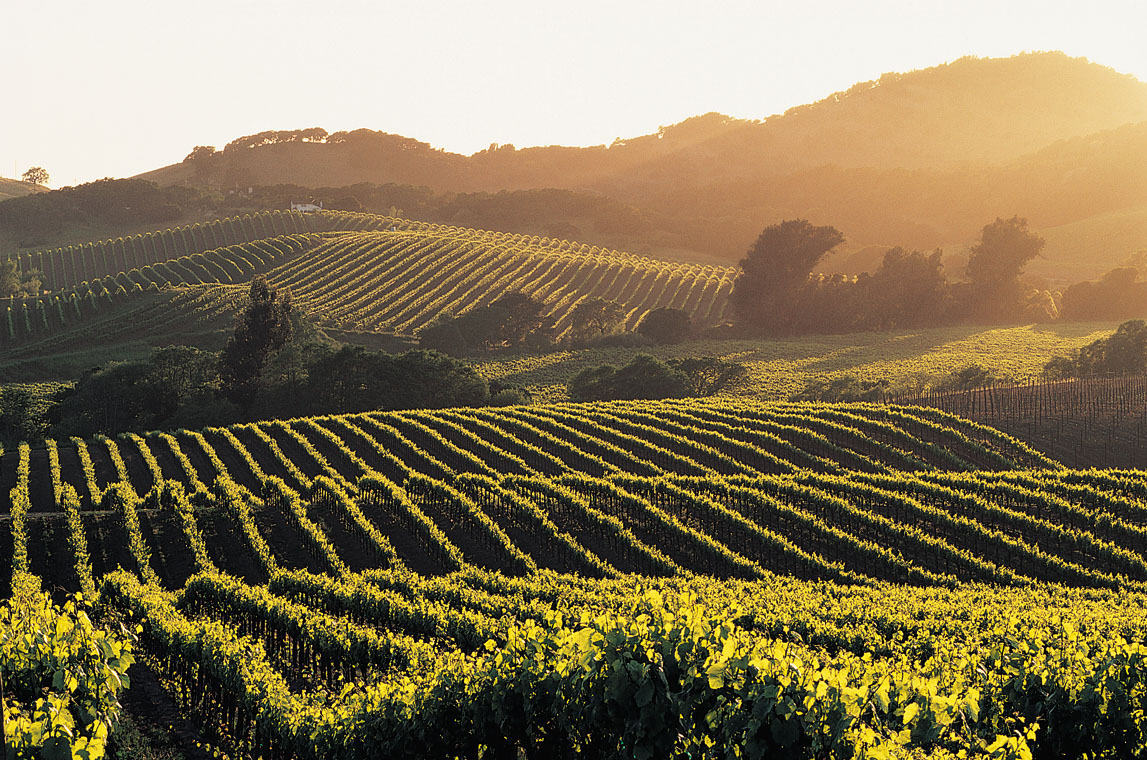
While the word “Napa” carries great cachet, evoking thoughts of California’s best wine, it’s surprising that the amenities in the town of Napa itself pale in comparison to other wine country locations. It does, however, feature some very good restaurants and more than comfortable, reasonably-priced B&B’s, like Churchill Manor, originally the home of Edward Churchill, whose lending institution became Bank of America.
500 Main Street
707-254-9690
www.celadonnapa.com
It was feared that when former
general manager Joel Tavizon and his wife, Tana,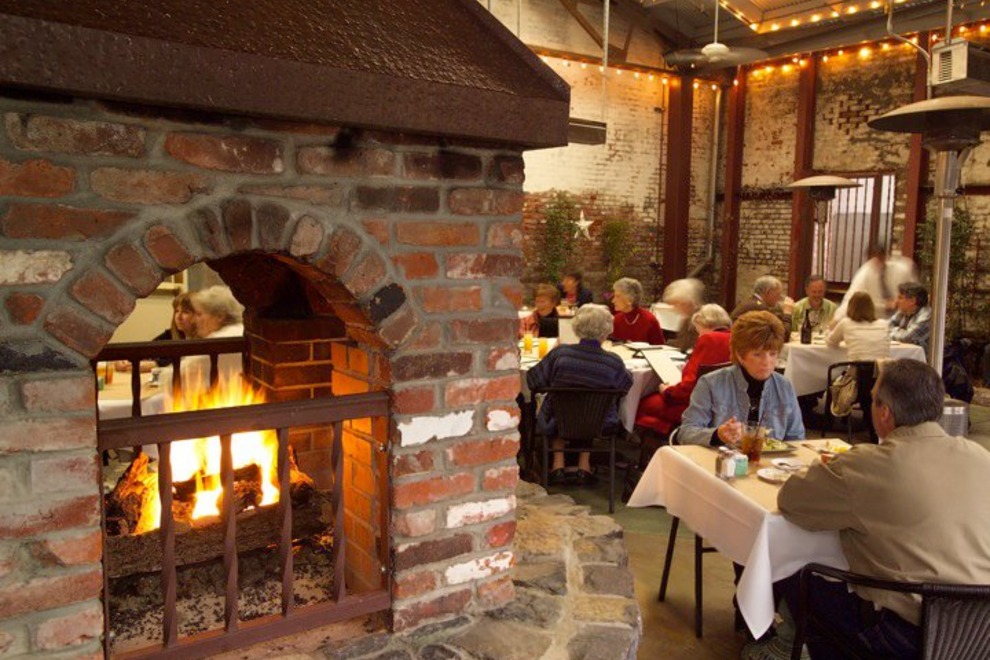 purchased this highly acclaimed
Michelin-recommended establishment two months ago
that its luster would dull. I’m happy to report that
it’s only better with long-time chef Marcos Uribe,
now a partner, at the top of his game and the
service smooth and professional.
purchased this highly acclaimed
Michelin-recommended establishment two months ago
that its luster would dull. I’m happy to report that
it’s only better with long-time chef Marcos Uribe,
now a partner, at the top of his game and the
service smooth and professional.
Dining takes place on small
tables in a large room featuring photos of locals
affixed to gray-green walls or in an outdoor (heated
when necessary) courtyard. From a choice of a dozen
appetizers, listed as “small plates” and “green
plates,” we selected a lusty, decadent mound of
crunchy chunks of braised pork belly served with
cubes of ripe watermelon and daikon doused with kecap manis
(Indonesian sweet soy sauce), and a plate of
perfectly cooked, succulent quail atop a bed of
crisp local greens (below).
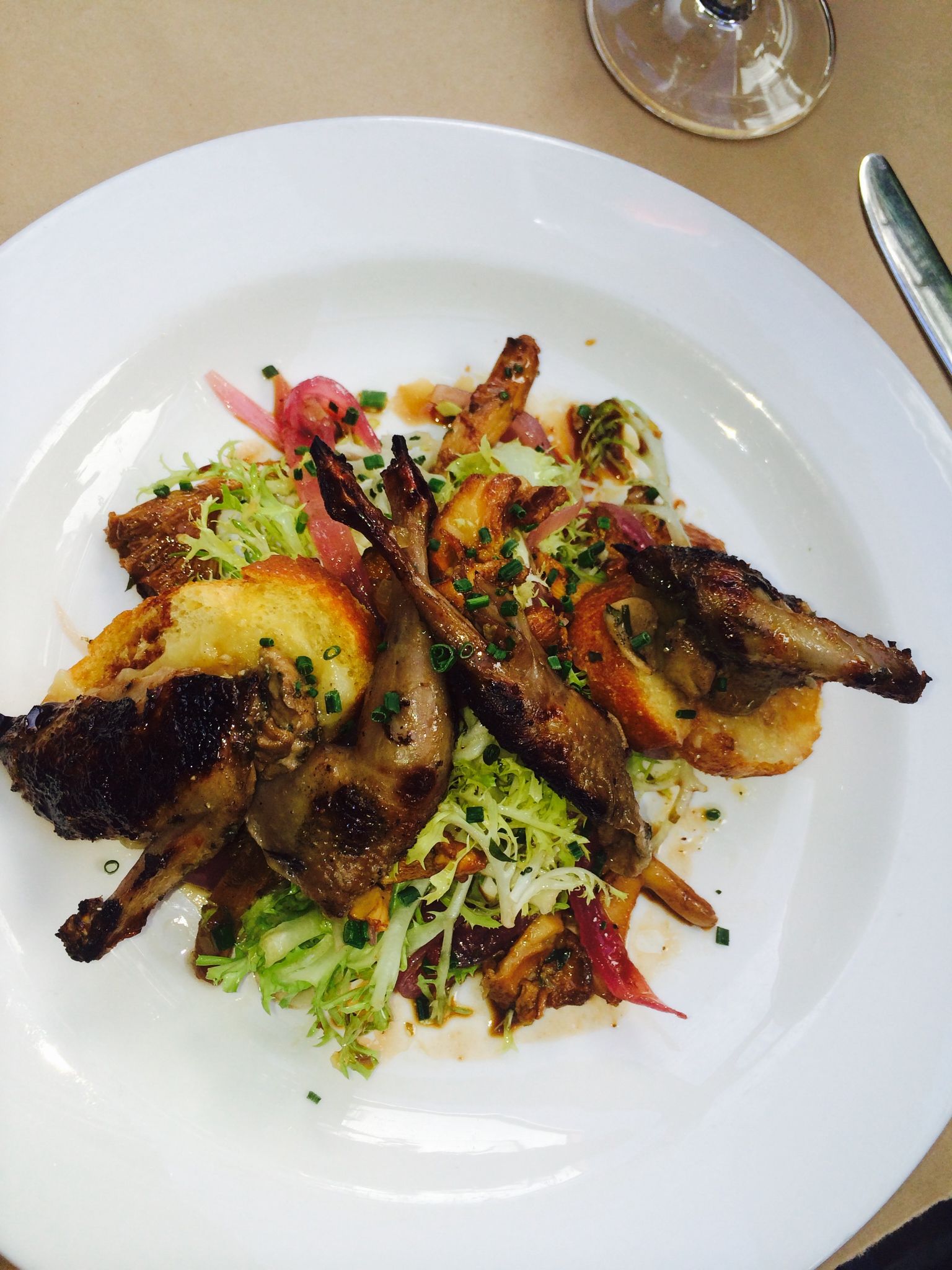 For main
courses (“big plates”) we went with a special of
grilled-to-the-moment cobia and fresh asparagus and
a thick, yet tender achiote-rubbed pork tenderloin
served with quinoa and a zesty mix of peppers,
grilled pineapple and lime-cured red onion. Dessert
of bread pudding was decadently rich and we
accompanied the meal with a bottle of fruity
Seghesio Zinfandel.
For main
courses (“big plates”) we went with a special of
grilled-to-the-moment cobia and fresh asparagus and
a thick, yet tender achiote-rubbed pork tenderloin
served with quinoa and a zesty mix of peppers,
grilled pineapple and lime-cured red onion. Dessert
of bread pudding was decadently rich and we
accompanied the meal with a bottle of fruity
Seghesio Zinfandel.
Open
nightly for dinner and Monday-Friday for lunch and
late afternoon dining. Expect
dinner for two to cost $110-$120. excluding wine,
tax and tip.
CARMEL VALLEY
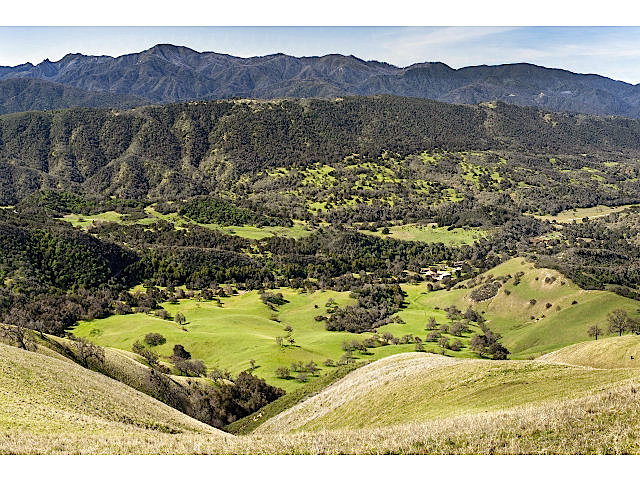
Visitors to the
Monterey Peninsula often flock to picturesque
Carmel-by-the-Sea, where typical tourist shops,
upscale emporiums like Tiffany’s and Bottega
Veneta, winery tasting rooms, and a range of
restaurants dot the streets of the barely
one-square-mile village. And the pace is often
frenetic. Those who sojourn to the area to relax
or just taste wine usually head to Carmel Valley,
with its low-key roadside village and nearby areas
featuring over 20 winery tasting rooms and the
newly renovated, spectacular, yet tranquil,
Bernardus Lodge & Spa.
LUCIA
Bernardus Lodge & Spa
415 West Carmel Valley Road
831-638-3400
www.bernarduslodge.com
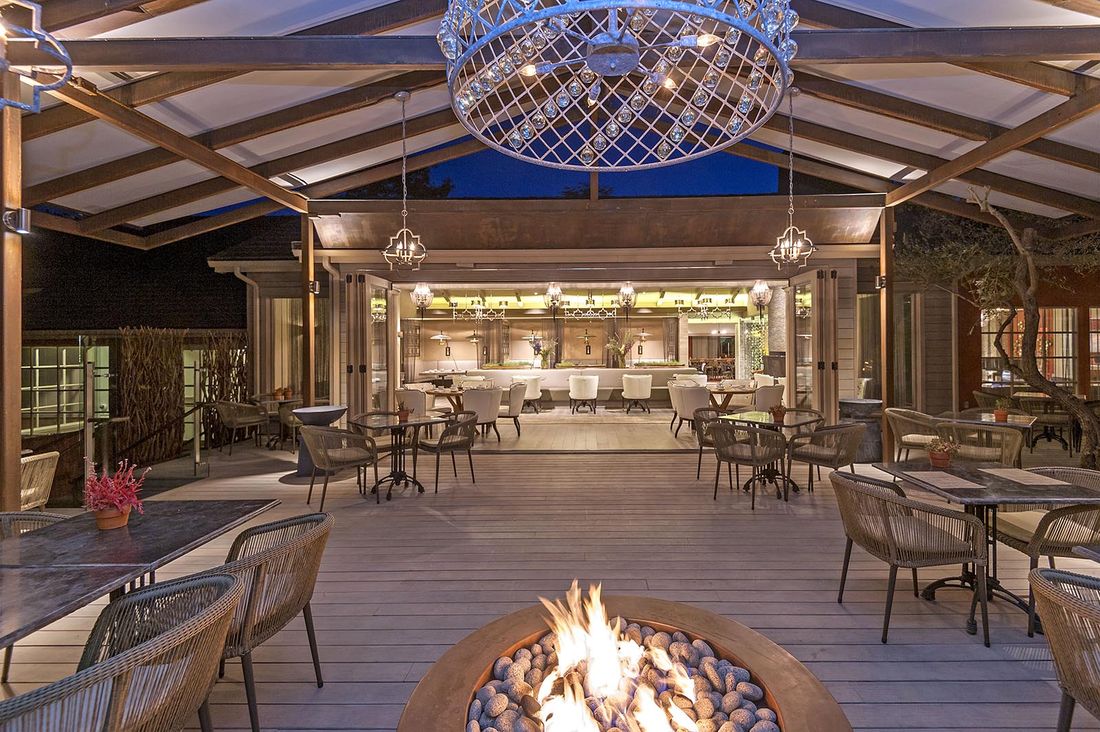
Lucia
is located in the space formerly occupied by Marinus
(just off the lobby of the recently totally
renovated Bernardus Lodge and Spa). And, while the
décor and physical space have changed--now with a
contemporary motif featuring beams of rough-hewn
wood, walls and floor in shades of gray and beige
and the addition of an outdoor dining area--the
long-time chef of Marinus, Cal Stamenov, still rules
the range here. In fact, it’s rumored that his
cuisine was one of the main reasons the luxury hotel
chain Noble House purchased Bernardus Lodge in 2013
from race-car driver/winery owner Ben Pons. We could
hardly disagree with Noble House’s decision, since
we enjoyed our first dinner here so much that we
canceled a reservation at another top-rated
establishment to dine at Lucia a second time. 
Some of the highlights of our two
meals--from a tasting menu one evening and a la
carte the other--included an appetizer of tender,
slow braised octopus served atop marinated sea beans
and another of a slice of smoked salmon with just
enough acidity to liven the dish from a
squeeze of Meyer lemon. An artichoke salad with fava
beans and pecorino came dressed in a zesty black
truffle vinaigrette; fragrant portobello mushroom
soup was thickened with goat’s cheese and drizzled
with white truffle oil; all were accompanied by a
loaf of fragrant, basil-laced focaccia.
Our main courses were a flavorful
Colorado lamb ribeye served with roasted root
vegetables and truffle jus, and
sweet seared day boat scallops served with thyme
roasted summer squash, sweet corn and a tangy onion
sauce.
For dessert there were milk
chocolate caramel petit cakes.
Service was prompt and
professional, with Manager Jeff Jung stopping by
just enough to explain how some of the dishes were
made and suggest wines from an extensive well-priced
list featuring local wineries.
Open for
breakfast, lunch and dinner daily.Expect
dinner for two to cost $120-$130, excluding wine,
tax and tip.
By John Mariani
LA SIRÈNE
558 Broome Street
(near
Varick Street)
212-925-3061
lasirenenyc.com
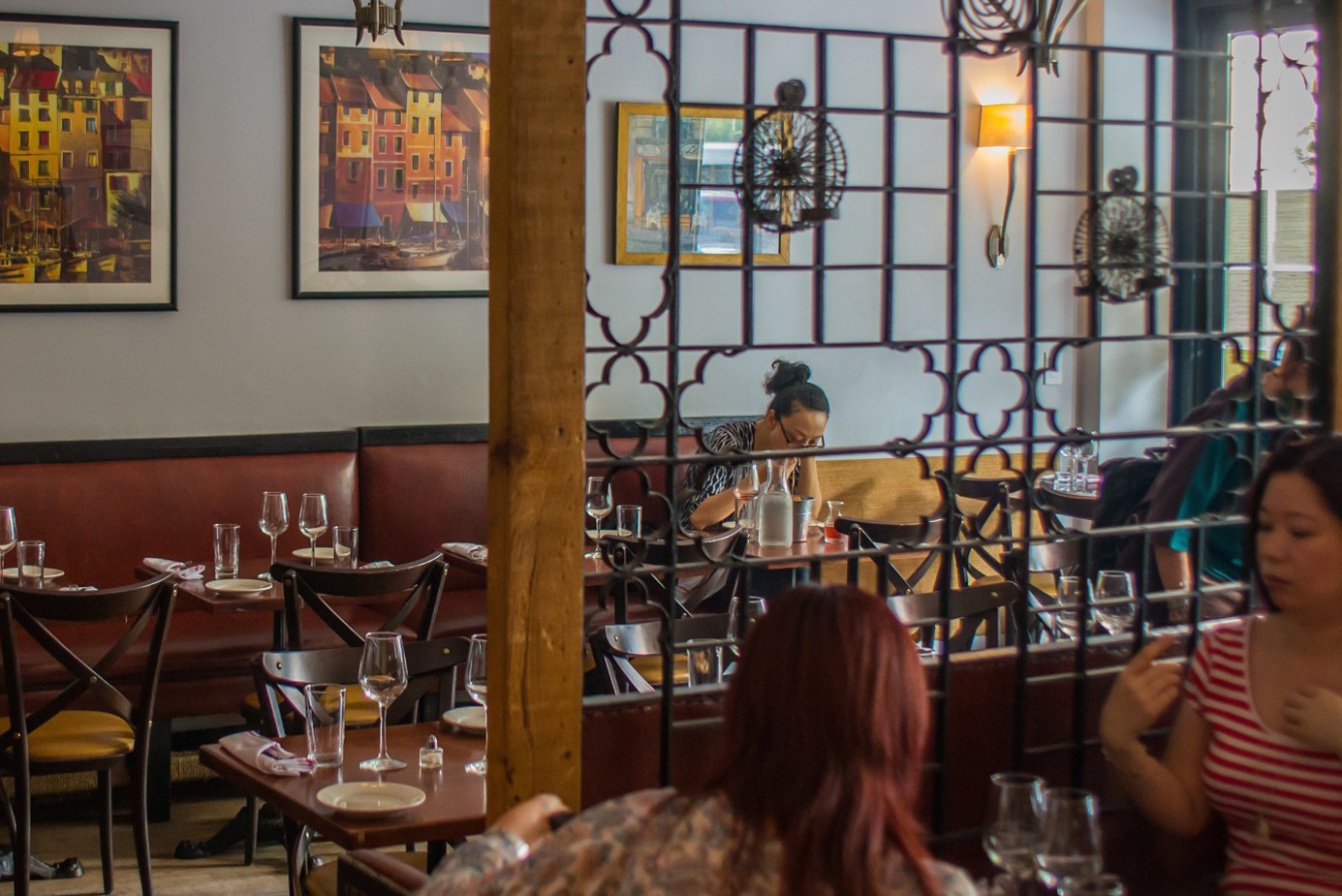
There are about 16,000 full-service
restaurants in NYC, so even the most
indefatigable gourmand can expect to happen upon
a true gem that has escaped his notice for
years. In
the case of La Sirène and me, eight years to be
exact, for chef-owner Didier Pawlicki opened
this little two-room, 46-seat bistro in SoHo in
2007--not the most opportune time. But
La Sirène survives, along with his fondue spot
named Taureau on the same premises and Le
Village on East 7th Street.
Pawlicki is a driven man, for
he assumes all chores, from sommelier to pastry
chef and, even though he was not at La Sirène the
night I dined there, his presence was palpable.
(His son was in the kitchen.) In any case, I was
not prepared to find La Sirène’s cooking so
thoroughly, deeply in tune with some of the best
bistros I’ve enjoyed in Paris itself; indeed, in a
city like New York,
with several good bistro examples, Le
Sirène is closest to the Parisian model in its food.
in its food.
I might
say that about the décor, too, for there are some
grim-looking bistros in Paris, but one of La
Sirène’s rooms is, to put it kindly, as drab as a
bar room that hasn’t seen an upgrade, ever. The
wooden wainscoting is dark brown, as are the
walls, so are the tables, the lighting weak, and
the artwork seems collected from a flea market. The other room is a
bit cheerier,with a wrought-iron screen and
lighter colors.
But upon my first taste of the
classic onion soup gratinée ($11.75), with its
bubbly, crusted Gruyère cheese and its sweet, soft
onions in a rich dark broth, I felt like Simon
Cowell when Susan Boyle broke into “I Dreamed a
Dream” on “Britain’s Got Talent.” I was astounded
how good it was.
As I was by a goat’s cheese tart with
shallots, truffles, raisin confit and Gruyère
($16.95).
We were offered a choice of
fresh foie gras or as a torchon, and I chose the former
($25)--a very
generous portion of the lobe, impeccably seared on
the outside and very creamy and pink inside in a
marvelously dark, thick, winey sauce reduction of
a kind you rarely see anymore. Mussels
(right)
come in various options: My wife chose
Creole-style ($14.75 appetizer, $26.75 main
course), plump but not-too-big bivalves in a pink
sauce laced with rum and heavy cream and a good
bite of chorizo sausage.
Also very special was another
example of how Pawlicki pays homage to tradition:
His gnocchi
à la parisienne, which are too often soft,
mushy and tasteless, were of good size, shape and
texture, lavished with a Mornay cream and cheese
gratin and truffles ($23.50).
 French bistros
used to serve rabbit stew (left) as a
matter of course, but it’s rare on menus today, so
it was a delight to find it on La Sirène’s, done
with abundant wild mushrooms, white wine, carrots
and herbs ($28.50) according to “an old family
recipe” that tasted exactly that way.
French bistros
used to serve rabbit stew (left) as a
matter of course, but it’s rare on menus today, so
it was a delight to find it on La Sirène’s, done
with abundant wild mushrooms, white wine, carrots
and herbs ($28.50) according to “an old family
recipe” that tasted exactly that way.
You
really learn some lessons at La Sirène, like the
right chewiness of an onglet steak poêlèe à la
luchonaise, cooked in good butter with
roasted garlic and sprinkled parsley ($29.75). And
even though it was summer’s end when I visited,
Pawlicki served a first-rate cassoulet
Toulouse-style ($32.50), with tender white beans,
sausage, and duck, which arrived in a large,
steaming casserole whose lusty contents are enough
for two, three or four people to share, as did we. It had
an intensity and depth of flavor I really haven’t
had outside of Toulouse, and the menu describes it
as “a Very Rich Dish which was served for Warriors
to defend their Village! Don’t take it if you can’t
bear it.”
Hard as it is to imagine a warrior even
getting up from the table after eating this
cassoulet much less marching into battle, it will
be an even more savory dish when the cool weather
comes this autumn.
From a kitchen that looks the
size of a shoebox one should not expect great
desserts, but, as with so much else that is quirky
about Le Sirène, 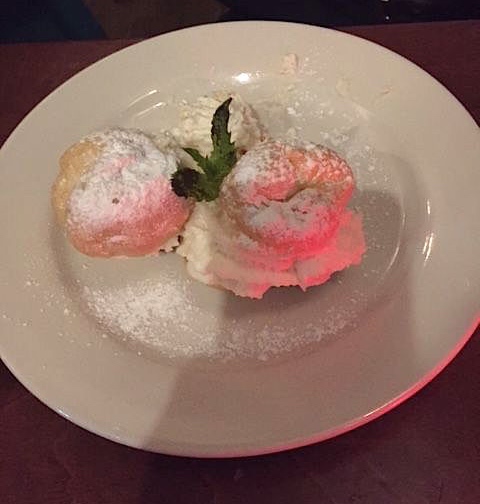 Pawlicki stays with the
classics and masters them, from an abundant
portion of choux
pastry (right)
stuffed with vanilla cream ($8.50) and big fat
profiteroles with bittersweet Caillebaut chocolate
sauce (worth the $13.75) to a raspberry tartlette
with fresh strawberries and cream ($9.75) to that
guiltiest of personal pleasure, île flottante
($9.75), everything was excellent.
Pawlicki stays with the
classics and masters them, from an abundant
portion of choux
pastry (right)
stuffed with vanilla cream ($8.50) and big fat
profiteroles with bittersweet Caillebaut chocolate
sauce (worth the $13.75) to a raspberry tartlette
with fresh strawberries and cream ($9.75) to that
guiltiest of personal pleasure, île flottante
($9.75), everything was excellent.
I found the wine list as
eccentric as everything else about La Sirène. It’s
on the short side, though understandably so for
such a small place, but the wines below $50 are
largely undistinguished and those above—like a
$184 Château LaGrange 2008 you’d find in a wine
store for about $50—very high priced. And in a
solidly French restaurant like this, why carry
California white zinfandel or a “house" Pinot
Grigio? You may also B.Y.O.B. for a $10 corkage
fee.
So.
What does one make of La Sirène? It’s a gem,
perhaps a little tarnished in ambiance, but
Pawlicki’s food is a consistent reminder of why so
many people love French bistros and their
unchanging menus.
Open for lunch Mon.-Sat.; Dinner
nightly; Three-course Early Bird Dinner $35.
❖❖❖
TWO BROTHERS INTENT ON MAKING PROSECCO
GO HEAD TO HEAD WITH CHAMPAGNE
By John Mariani
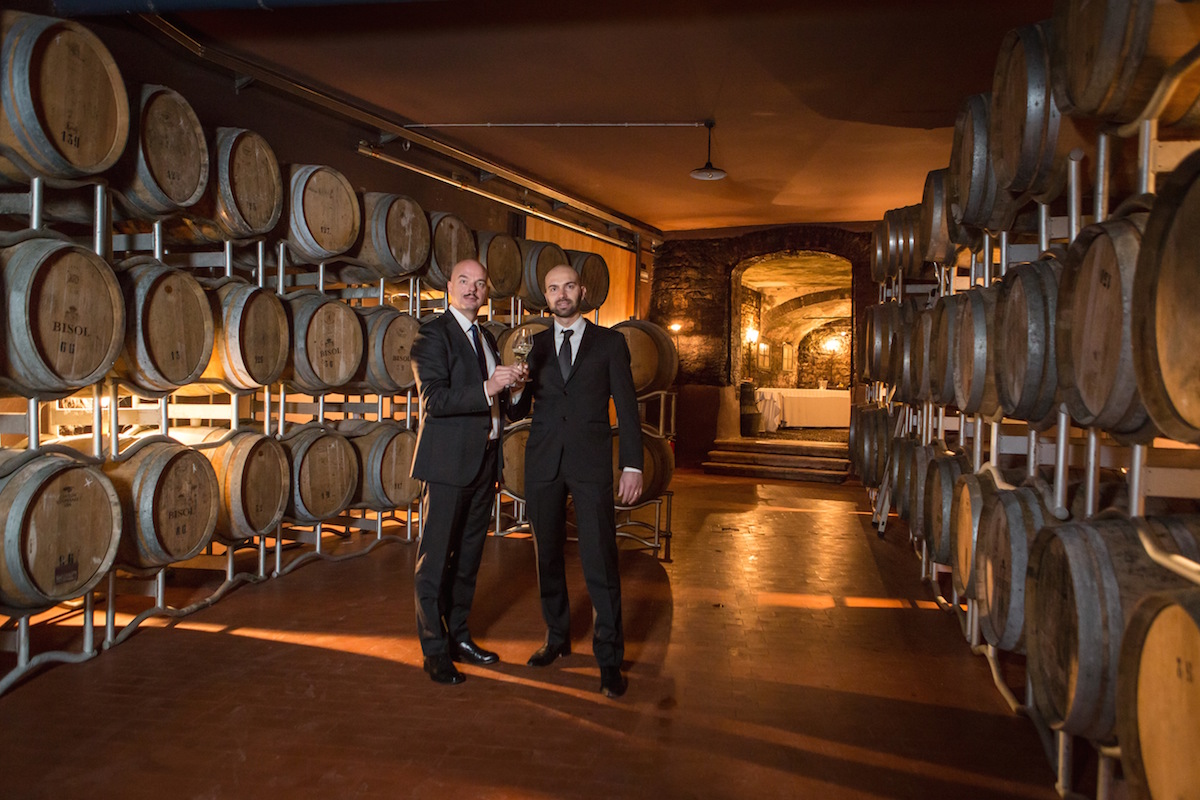 Gianluca
Bisol, President and CEO of the namesake Italian
winery he co-owns with his brother, enologist
Desiderio (left),
was sitting at New York’s most iconic
restaurant, `21’ Club, biting into its massive
$36 signature hamburger with ketchup and crisp
French fries.
Gianluca
Bisol, President and CEO of the namesake Italian
winery he co-owns with his brother, enologist
Desiderio (left),
was sitting at New York’s most iconic
restaurant, `21’ Club, biting into its massive
$36 signature hamburger with ketchup and crisp
French fries.
“This is fantastic!” he
exclaimed, “ and look how well it goes with
Prosecco.” In
fact, the sparkling wine from Italy’s Veneto
region was delicious with the rare burger, as it
was with a platter of Florida stone crabs and
grilled Dover sole.
“People think of prosecco as an
aperitif and as an ingredient in the bellini
cocktail, but a good one like Bisol is a very
versatile wine: perfect with seafood and, because
it’s sparkling, it helps refresh the palate when
you’re eating a hamburger with ketchup and French
fries.”
Gianluca should know: his
family has been making wine in the Valdobbiadene
and Conegliano regions since 1542, and they’ve
been expanding—now with more than 20 plots of land
in the most prestigious zones for Prosecco, which
under Italian wine laws is a “D.O.C.G.” (a wine
guaranteed to be of a specific controlled origin).
Bisol also directly manages three hectares on the
Cartizze hill (below),
whose location and terroir make it one of the
world’s most valuable wine terroir, estimated
at 2.5 million euros per hectare. Bisol’s
family motto remains “Excellence from the ground 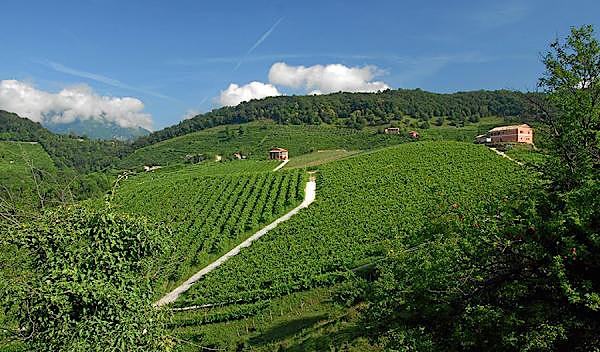 to the bottle.”
to the bottle.”
“We work with great passion so that
Conegliano can have the same prestige as Reims and
Valdobbiadene the same appeal as Épernay,” said
Gianluca, referring to the regions in France where
the finest Champagnes are made. “But
such a reputation only comes with passion and
investment. Every day my
brother and I are presented with at least one
opportunity for improvement.”
Bisol, along with a slew of
other Prosecco producers in the Veneto—some
producing sweet, fizzy stuff hardly worthy of the
name—have reason to gloat: Prosecco has
transcended its image as a cheap bubbly best used
in making Italian cocktails (the bellini was
invented decades ago at Harry’s Bar in Venice,
combining white peach juice with Prosecco), so
that today sales surpass that of Champagne, with
307 million bottles of Prosecco sold globally in 2013
versus 304 million of Champagne. In
Great Britain alone this year sales have increased
72 percent.
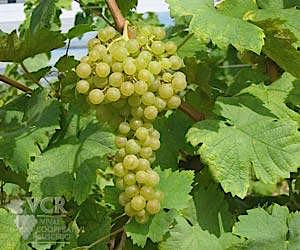 Still,
Bisol has to fight the old image, even to the
point of differentiating Prosecco from Asti
Spumante, a sparkling, sweet wine from Piedmont
made with the moscato grape and Lambrusco from
Emilia-Romagna.
There is also competition from the region
of Franciacorta, whose producers make their
sparkling wine by the laborious and expensive “Champagne
method." Prosecco,
made from Glera grapes (left), is made by the bulk
Charmat process by which the natural secondary
fermentation of the wine is produced in a tank
rather than in bottles. Most Prosecco is not vintage
dated.
Still,
Bisol has to fight the old image, even to the
point of differentiating Prosecco from Asti
Spumante, a sparkling, sweet wine from Piedmont
made with the moscato grape and Lambrusco from
Emilia-Romagna.
There is also competition from the region
of Franciacorta, whose producers make their
sparkling wine by the laborious and expensive “Champagne
method." Prosecco,
made from Glera grapes (left), is made by the bulk
Charmat process by which the natural secondary
fermentation of the wine is produced in a tank
rather than in bottles. Most Prosecco is not vintage
dated.
“Using the Charmat process is
better for Prosecco, which is not made to be
aged,” said Gianluca. “It keeps the freshness and
sparkle of the wine while preserving its fruit. We have
done some experiments with the Champenoise method
with our Eliseo
Bisol Cuvée del Fondatore, made from from
a selection of the best Pinot Bianco, Chardonnay,
and Pinot Nero grapes, then aged for a minimum of
100 months.”
Bisol is the biggest producer
of Prosecco in the region and certainly the most
innovative. What
I like about their wines is precisely that fruit
characteristic, with just a touch of sweetness,
all of it buoyed by the bubbles and exceptional
freshness because of the acidic content. So many
Proseccos are either two sweet or too unbalanced,
whereas Bisol's equilibrium of elegance and
stimulating effervescence combines with green
apple sweet-sour flavors that do indeed go well
with all kinds of foods.
Bisol’s range of Proseccos are
of various degrees of dryness.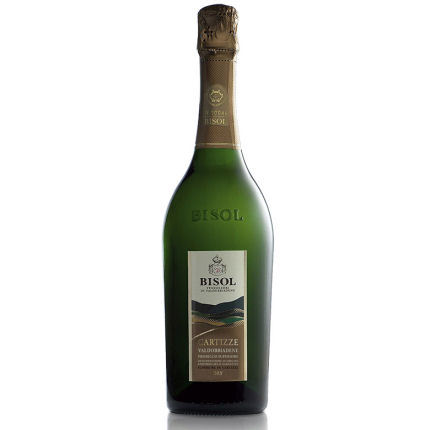
Jeio
($15) has a less pronounced sparkle and
wonderful aroma. Made from carefully selected
grapes, Jeio is a nickname for Desiderio given him
by his wife.
It is perhaps the most amiable expression
of the terroir of the best plots of
Valdobbiadene. Bisol also makes an
enchanting rosé version.
Prosecco Crede
($18) is a blend of 85 percent Glera, 10 percent
Pinot Bianco, and 5 percent Verdiso. When compared
with other Proseccos of the same or lesser price,
its superiority comes into clear focus. The name comes
from the clay-rich soil it grows in, and it
has that clean, well-constructed equilibrium that
makes it easy to enjoy with just about any meal
that isn’t too heavy with garlic or vegetables
like asparagus.
Coming from that very expensive Cartizze vineyard,
Prosecco
Superiore Cartizze (right) is a cru,
referring to a specific vineyard, a definition
Bisol pioneered in the region. This is one
of the most refined of Bisol’s wines, with
more body but great delicacy. It’s
superb with cheeses or lightly sweet desserts. I’ve seen
it priced between $45 and $60 in U.S. wine stores.
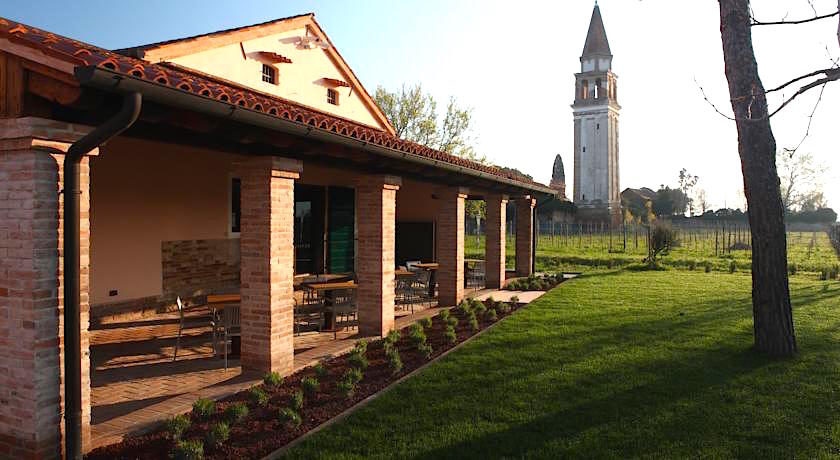 Given
their success, the Bisol family has invested in
agrotourism in the Veneto, which includes Venissa
(left),
an ancient walled vineyard in the Venetian lagoon
where they produce a dry wine called Venissa from
the Dorona varietal—a grape once thought extinct.
They have also invested in the Maeli winery in the
Euganaen Hills, producers of
a Moscato Giallo.
Given
their success, the Bisol family has invested in
agrotourism in the Veneto, which includes Venissa
(left),
an ancient walled vineyard in the Venetian lagoon
where they produce a dry wine called Venissa from
the Dorona varietal—a grape once thought extinct.
They have also invested in the Maeli winery in the
Euganaen Hills, producers of
a Moscato Giallo.
The dilemma of Prosecco
producers today is that on the one hand they have
been wildly successful in selling their
easy-to-like sparklers; on the other, producers
like Bisol wish to compete with Champagne not just
in sales—a battle it has already won—but in
reputation, which makes the Bisol brothers work
all the harder.
❖❖❖

“My
companion
and I sit in the smaller room. The table, says the
waiter, is blond maple wood and surpassingly smooth;
it is sanded between every service because each drip
leaves a stain. I have never before met a table that
thinks it is a tablecloth. There is Japanese writing
on the wall. I ask the waiter: “What does it mean,
this writing?” “No one knows,” he says quietly. “It
is in a dialect so obscure it cannot be translated.”
It is literally incomprehensible.”—Tanya Gold, “A
Goose in a Dress,” Harper Magazine (Sept. 2015).

GIVES A WHOLE NEW MEANING TO "DOING SHOTS"
Daytona
Beach city officials have approved plans to allow Ron
Perkinson to open a gun range attached to a bar and
restaurant called Volusia Top Gun.
After initially being turned down, Perkinson said
he refused to take no for an answer. "When it got shot
down, I realized I needed to bring more to the table to
show them how this business runs," he said.
Any of John Mariani's books below may be ordered from amazon.com.
 I'm proud and happy to announce that my
new book, The Hound
in Heaven (21st Century Lion Books), has just
been published through Amazon and Kindle.
I'm proud and happy to announce that my
new book, The Hound
in Heaven (21st Century Lion Books), has just
been published through Amazon and Kindle. It is a novella, and for anyone who loves dogs, Christmas, romance, inspiration, even the supernatural, I hope you'll find this to be a treasured favorite. The story concerns how, after a New England teacher, his wife and their two daughters adopt a stray puppy found in their barn in northern Maine, their lives seem full of promise. But when tragedy strikes, their wonderful dog Lazarus and the spirit of Christmas are the only things that may bring back his master back from the edge of despair.
WATCH THE VIDEO!
“What a huge surprise turn this story took! I was completely stunned! I truly enjoyed this book and its message.” – Actress Ali MacGraw
“He had me at Page One. The amount of heart, human insight, soul searching, and deft literary strength that John Mariani pours into this airtight novella is vertigo-inducing. Perhaps ‘wow’ would be the best comment.” – James Dalessandro, author of Bohemian Heart and 1906.
“John Mariani’s Hound in Heaven starts with a well-painted portrayal of an American family, along with the requisite dog. A surprise event flips the action of the novel and captures us for a voyage leading to a hopeful and heart-warming message. A page turning, one sitting read, it’s the perfect antidote for the winter and promotion of holiday celebration.” – Ann Pearlman, author of The Christmas Cookie Club and A Gift for my Sister.
“John Mariani’s concise, achingly beautiful novella pulls a literary rabbit out of a hat – a mash-up of the cosmic and the intimate, the tragic and the heart-warming – a Christmas tale for all ages, and all faiths. Read it to your children, read it to yourself… but read it. Early and often. Highly recommended.” – Jay Bonansinga, New York Times bestselling author of Pinkerton’s War, The Sinking of The Eastland, and The Walking Dead: The Road To Woodbury.
“Amazing things happen when you open your heart to an animal. The Hound in Heaven delivers a powerful story of healing that is forged in the spiritual relationship between a man and his best friend. The book brings a message of hope that can enrich our images of family, love, and loss.” – Dr. Barbara Royal, author of The Royal Treatment.
 |
The Encyclopedia of American Food and Drink by John F. Mariani (Bloomsbury USA, $35) Modesty forbids me to praise my own new book, but let me proudly say that it is an extensive revision of the 4th edition that appeared more than a decade ago, before locavores, molecular cuisine, modernist cuisine, the Food Network and so much more, now included. Word origins have been completely updated, as have per capita consumption and production stats. Most important, for the first time since publication in the 1980s, the book includes more than 100 biographies of Americans who have changed the way we cook, eat and drink -- from Fannie Farmer and Julia Child to Robert Mondavi and Thomas Keller. "This book is amazing! It has entries for everything from `abalone' to `zwieback,' plus more than 500 recipes for classic American dishes and drinks."--Devra First, The Boston Globe. "Much needed in any kitchen library."--Bon Appetit. |
"Eating Italian will never be the same after reading John Mariani's entertaining and savory gastronomical history of the cuisine of Italy and how it won over appetites worldwide. . . . This book is such a tasteful narrative that it will literally make you hungry for Italian food and arouse your appetite for gastronomical history."--Don Oldenburg, USA Today. "Italian
restaurants--some good, some glitzy--far
outnumber their French rivals. Many of
these establishments are zestfully described
in How Italian Food Conquered the World, an
entertaining and fact-filled chronicle by
food-and-wine correspondent John F.
Mariani."--Aram Bakshian Jr., Wall Street
Journal.
"Equal parts
history, sociology, gastronomy, and just
plain fun, How Italian Food Conquered the
World tells the captivating and delicious
story of the (let's face it) everybody's
favorite cuisine with clarity, verve and
more than one surprise."--Colman Andrews,
editorial director of The Daily
Meal.com. "A fantastic and fascinating
read, covering everything from the influence
of Venice's spice trade to the impact of
Italian immigrants in America and the
evolution of alta cucina. This book will
serve as a terrific resource to anyone
interested in the real story of Italian
food."--Mary Ann Esposito, host of PBS-TV's
Ciao
Italia. "John Mariani has written the
definitive history of how Italians won their
way into our hearts, minds, and
stomachs. It's a story of pleasure over
pomp and taste over technique."--Danny Meyer,
owner of NYC restaurants Union Square
Cafe, The Modern, and Maialino.
|
 |
 |
 |
 |
 |
 |
 |
 |
 Everett Potter's Travel Report:
Everett Potter's Travel Report: 
 Eating Las Vegas
is the new on-line site for Virtual Gourmet
contributor John A. Curtas., who since 1995
has been commenting on the Las Vegas food
scene and reviewing restaurants for Nevada
Public Radio. He is also the
restaurant critic for KLAS TV, Channel 8 in
Las Vegas, and his past reviews can be
accessed at KNPR.org.
Click on the logo below to go directly to
his site.
Eating Las Vegas
is the new on-line site for Virtual Gourmet
contributor John A. Curtas., who since 1995
has been commenting on the Las Vegas food
scene and reviewing restaurants for Nevada
Public Radio. He is also the
restaurant critic for KLAS TV, Channel 8 in
Las Vegas, and his past reviews can be
accessed at KNPR.org.
Click on the logo below to go directly to
his site.

Tennis Resorts Online: A Critical Guide to the World's Best Tennis Resorts and Tennis Camps, published by ROGER COX, who has spent more than two decades writing about tennis travel, including a 17-year stretch for Tennis magazine. He has also written for Arthur Frommer's Budget Travel, New York Magazine, Travel & Leisure, Esquire, Money, USTA Magazine, Men's Journal, and The Robb Report. He has authored two books-The World's Best Tennis Vacations (Stephen Greene Press/Viking Penguin, 1990) and The Best Places to Stay in the Rockies (Houghton Mifflin, 1992 & 1994), and the Melbourne (Australia) chapter to the Wall Street Journal Business Guide to Cities of the Pacific Rim (Fodor's Travel Guides, 1991).


MARIANI'S VIRTUAL GOURMET
NEWSLETTER is published weekly. Editor/Publisher: John
Mariani.
Editor: Walter Bagley. Contributing Writers: Christopher Mariani,
Robert Mariani, Misha
Mariani,
John A. Curtas, Edward Brivio, Mort Hochstein,
Andrew Chalk, Dotty Griffith and Brian Freedman. Contributing
Photographers: Galina Dargery, Bobby
Pirillo. Technical Advisor: Gerry McLoughlin.
To un-subscribe from this newsletter,click here.
© copyright John Mariani 2015

